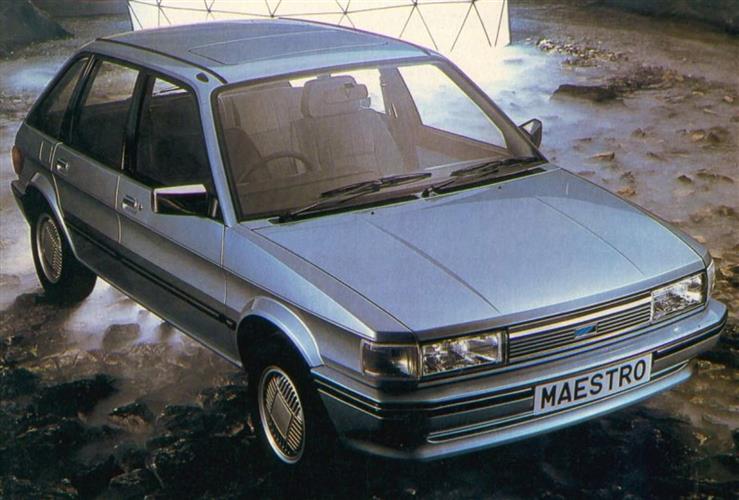BANGERS AND MASH (some text hidden) --NONE--
BY ANDY ENRIGHT
Introductionword count: 137
Born in a time of extreme industrial turbulence, the Rover (nee Austin) Maestro never recovered from a bad start. Initially slated for a 1979 launch, British Leyland's co-operation with Honda resulted in the 1981 launch of the Triumph Acclaim, the Maestro being held over until 1983 when Austin Rover had risen from the ashes of BL. What interest can there be for the used car buyer in a design that was already four years out of date when it was launched and which has now metamorphosed into a national totem of the near-death of the British motoring industry? Yes, you do get a lot of metal for your money but only when measured in area rather than volume. Nonetheless, it represents honest motoring for the unpretentious and 'post-modern irony' for urban trendies. How can you possibly refuse?
Modelsword count: 14
Models Covered: (5dr 1.3, 1.6, 2.0 petrol,2.0 Diesel, [LX, DLX, MG 2.0i, MG Turbo])
Historyword count: 548
The Maestro's initial designs were created by one Charles Spencer King, a gentleman whose curriculum vitae probably devotes more attention to another of his designs, the Range Rover. The design criteria applied to the Maestro make good late seventies vintage sense. Pack a large interior into compact exterior dimensions, make it airy with good all round visibility, fuel efficient and mechanically simple. With a reinforced suspension setup copied from Volkswagen's Polo, the Maestro went the tried and tested route. Unfortunately, this unremarkable formula was hijacked when the Austin Rover Group was formed. Looking for a headline-grabbing successor to the Maxi and Allegro ranges that would compete fairly and squarely against the Ford Escort and Volkswagen Golf, a whole yard sale of hastily conceived 'advanced technology' got levered into the car in time for its 1983 launch. Little of it worked. Dubbed "Cowley's Computer Car", the Maestro's famous talking dash wowed customers for several minutes before they started devising horrible deaths for Nicolette Mackenzie, the innocent actress who provided the voice for it. The digital instrument panel was very Blakes Seven, being replaced by some analogue instruments that actually worked in 1984. Other technological lowlights of the Maestro range included the flatulent HLE economy model's 'Econometer', a vacuum gauge with a sealing fault that caused it to let loose a deafening and hugely embarrassing fart under hard acceleration. Then there was the MG Maestro 1600 that vaporised all its fuel in the carburettors when it got hot and boasted build quality that once saw this particular journalist write one off in a 5mph traffic shunt. A huge glut of woeful models followed, and it's probably best to write off the first nine years of Maestro production as one expensive learning process for Austin Rover. In 1988, the Austin badge disappeared completely and the range was badged as Rover Maestro for the first time. With the original square dashboard having been consigned to the dumpster of history and a revised model line up, perhaps 1990 should for all intents and purposes be taken as Year 0 for the Maestro. The range comprised the 1.3-litre Clubman, 1.3-litre LX, 1.6-litre LX Auto, 2.0-litre DLX, MG 2.0i, MG turbo and the 2.0-litre Clubman Turbo diesel. The surprisingly quick MG models were axed in 1992. The rest of the range was picked off one by one until the last of the 2.0-litre turbo diesel models rolled off the Cowley production line at the tail end of 1994. However, like a bad aftertaste, the Maestro was to return. An agreement to ship body shells to Bulgaria in 1994 was scuppered by enterprising British criminals finding a ready market for stolen Maestros. Until the police made the connection, constabularies up and down the country were puzzled by the soaring incidence of Maestro theft. Instead kits went to Syria, Jordan, Uruguay, Argentina and, latterly, Macedonia. Rumours that this was the cause of ethnic Albanian unrest have yet to be disproved. Around 600 kits were unsold until Trans European Trading, a small company based in Ledbury, Herefordshire, stepped in and offered the cars with 1.3-litre engines. So yes, it's theoretically possible to buy a new/nearly-new Rover Maestro. Likewise, it may or may not be possible to kick yourself to death, but it's probably best not to find out.
What You Getword count: 105
By 1990 much of the inherent weaknesses of the earlier models had been ironed out. Granted, the Maestro was still built of metal so thin that foil would be a more adequate description and the echo from a clanging Maestro door is still being picked up by radio telescopes the world over, but it was reasonably well sorted. Unfortunately by this point the Maestro was now so far off the pace that it was bought solely by senile nonagenarians, skinflint patriots and dewy-eyed nostalgists. Nevertheless, it no longer self-immolated, turned to an oxidized wreck at the first hint of rain nor spontaneously electrocuted its operator.
To see the full road test text contact us on 0330 0020 227
Pictures (high res disabled)

Scoring (subset of scores)
Category: Compact Family Cars
| Performance | |
| Handling | |
| Comfort | |
| Space | |
| Styling, Build, Value, Equipment, Depreciation, Handling, Insurance and Total scores are available with our full data feed. | |



